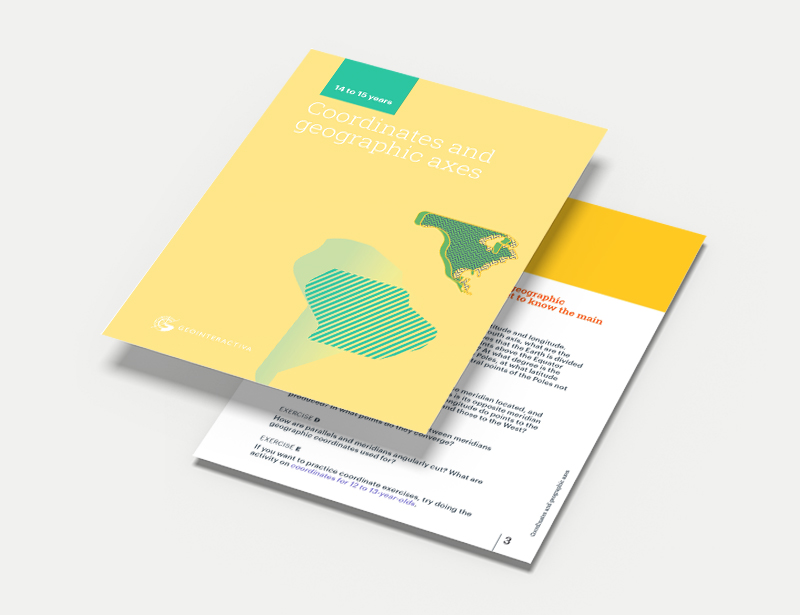
secondary (14-15 years)
Geographic coordinates
In this activity you will discover that geographic coordinates are a reference system that is used to locate any point on the Earth’s surface. This system is made up of two angular measurements: latitude and longitude.
In this downloadable you will find a PDF resource with instructions to energize your classes. On the one hand, we show you which platform tool you will work with and, on the other hand, we propose activities suitable for students aged 14-15.
Do you want your classes to be stimulating? Get started today with Geointeractiva.
We propose to teach geography in a fun way
What will your students learn with this educational activity?
Geographic coordinates are a reference system used to locate any point on the Earth’s surface
This system consists of two angular measures: latitude and longitude. Latitude measures the angular distance of a point from the equator, while longitude measures the angular distance of a point from the Prime Meridian. In this article, the most important concepts related to geographic coordinates will be presented so that high school students can understand their use and applications in geography.
Concepts of Latitude and Longitude
Latitude and longitude are angular measures used to locate any point on the Earth’s surface. Latitude is measured in degrees, minutes, and seconds and varies between 0° at the equator and 90° at the poles. Longitude is also measured in degrees, minutes, and seconds and varies between 0° at the Prime Meridian and 180° at the opposite meridian. Points located on the equator have a latitude of 0°, while points located at the poles have a latitude of 90°. The Prime Meridian is the reference point for measuring longitude.
Latitude above the equator and latitude of the poles
Latitude is the angular measure of the distance separating a point from the equator. Points located above the equator have a positive latitude, while points located below the equator have a negative latitude. For example, the city of New York is located in the northern hemisphere and has a latitude of approximately 40°N.
The poles are the northernmost and southernmost points on the Earth. The North Pole has a latitude of 90°N, while the South Pole has a latitude of 90°S. At these points, latitude is maximum, and any point located on them is at the extreme north or south of the planet.
The central points of the poles have no longitude
Unlike latitude, longitude is not a linear measure of distance, but an angular measure of a point’s position relative to the Prime Meridian. In this sense, the central points of the poles have no longitude since any meridian passing through them would be perpendicular to the Prime Meridian.
Main Meridians
There are two meridians of special importance in geography: the Prime Meridian and the 180° meridian. The Prime Meridian is the reference point for measuring longitude and divides the planet into two hemispheres: east and west. The 180° meridian, also known as the antimeridian, is the opposite meridian to the Prime Meridian and divides the planet into two hemispheres: west and east. Unlike the Prime Meridian, the 180° meridian is not a reference point for measuring longitude, but an imaginary meridian used to establish the international date line.
Maximum Separation between Meridians and Points of Convergence
The maximum separation between meridians occurs at the equator, where the meridians are farthest apart. In contrast, at the poles, the meridians converge at a single point, meaning that any line passing through the poles will be a meridian. Additionally, meridians get closer to each other as they approach the poles.
As for parallels, these are imaginary circles traced on the Earth’s surface in an east-west direction. All points located on the same parallel have the same latitude. Parallels intersect with meridians forming a right angle at each point of intersection.
Angular Intersections of Parallels and Meridians
Parallels and meridians intersect at an angle at each point of intersection. If we observe a globe, we will see that the parallels are equidistant from each other and that each one forms a complete circle around the planet. Meridians, on the other hand, intersect at the poles and widen towards the equator, forming straight lines that converge at the poles.
Conclusion
In summary, geographic coordinates are a reference system used to locate any point on the Earth’s surface. Latitude and longitude are angular measurements used to determine the position of a point with respect to the Equator and the Prime Meridian. Points located above the Equator have a positive latitude, while points located below the Equator have a negative latitude. The poles are the most northern and southern points on Earth and have a latitude of 90°. The Prime Meridian and the 180° meridian are the two main meridians that divide the planet into two hemispheres. The central points of the poles have no longitude, as any meridian passing through them would be perpendicular to the Prime Meridian. The maximum separation between meridians occurs at the equator, while at the poles, meridians converge at a single point. Parallels and meridians intersect at an angle at each point of intersection, forming a right angle.
With this information, high school students will be able to better understand the concepts related to geographic coordinates and their use in geography. Through this tool, they will be able to locate any point on the Earth’s surface and better understand the distribution of continents, oceans, countries, and cities in the world.”